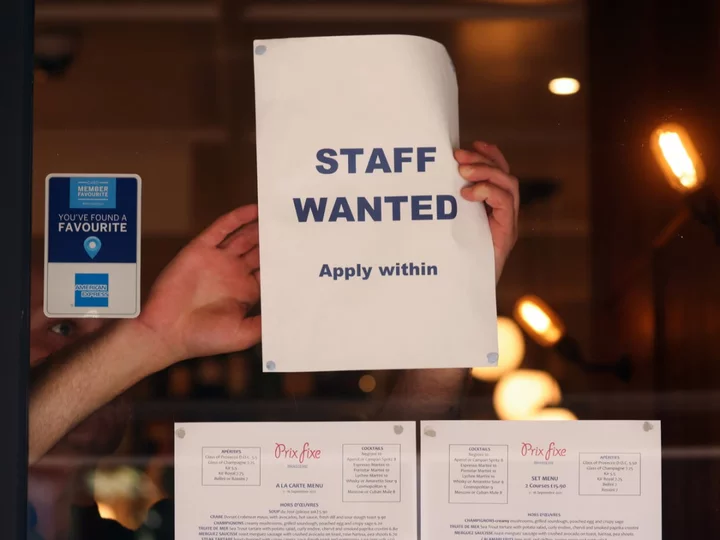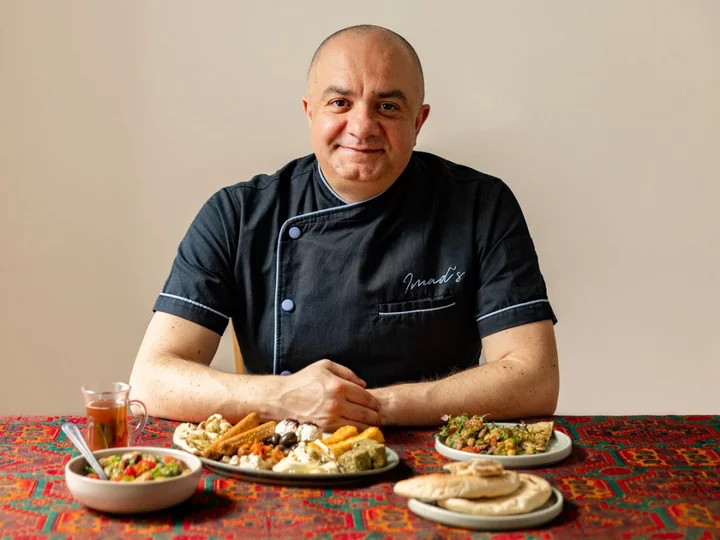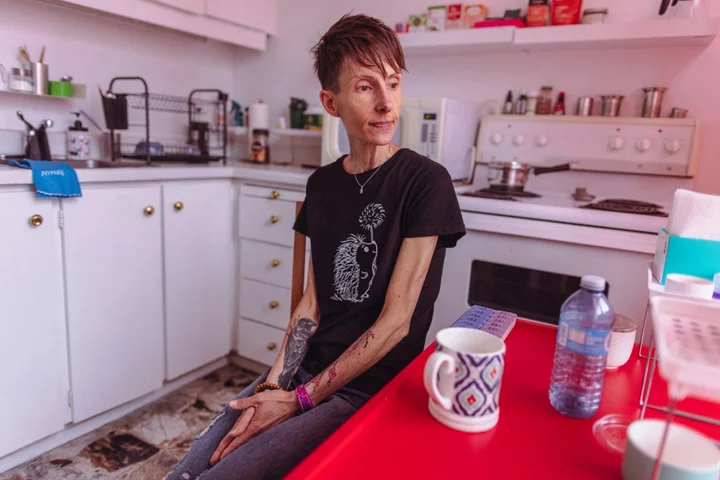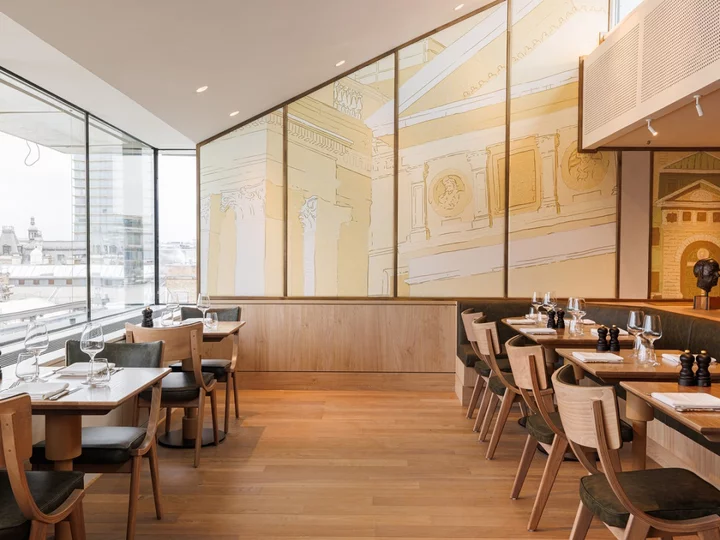
Gemma Atkinson gives birth to second baby with Strictly Come Dancing’s Gorka Marquez
Gemma Atkinson has given birth to her second child with Strictly Come Dancing professional dancer Gorka Marquez. The former Emmerdale actor, 38, announced on Instagram that she and her fiancé had welcomed a baby son, whom she called “utterly wonderful”. Writing on her Instagram Stories on Wednesday morning (19 July), Atkinson told her 1.8m followers: “Little man is here! He arrived safe and sound and he’s utterly wonderful. “We’re all home together soaking up this lovely little bubble before Gorks has to leave for Strictly rehearsals next week.” She added: “Thank you for all the lovely well wishes. Our family is complete.” Her partner Marquez shared the same message on his own Instagram page. The couple, who already share a three-year-old daughter, Mia, met when Atkinson appeared on Strictly Come Dancing as a celebrity contestant in 2017. Though they were not coupled up on the dancefloor, the pair started dating after the show wrapped. When Atkinson gave birth to their first child, Mia, in 2019, she needed an emergency c-section and suffered a haemorrhage after the birth, losing nearly a litre of blood. Following the experience she said she was initially “adamant” that she and Marquez would not want another child. “All these things were going through my mind, what did I do that caused all that to happen? I was telling myself for weeks and weeks I’d failed at childbirth,” the actor told Channel 4’s Steph’s Packed Lunch last year. “I was having horrible dreams that someone was going to take Mia from me. I remember my mum running into my bedroom and I was sat up screaming, sweating.” Atkinson added that a woman approached her and her mum when she was out with Mia one day and said: “Oh I believe it [the birth] wasn’t a success was it, you know, what happened?” Atkinson’s mother replied: “It was a huge success, Mia’s there, Gemma’s here, total success.” “Something clicked in me then,” Atkinson said of the exchange. “My body had done me proud because it had recovered and got me through. “I’m at the stage where I want a sister or brother for Mia. The first few months of Mia’s life, I kept saying to my partner, Gorka, ‘I’m not going through that again’. I’ve now come out of it and I feel I could.” According to the Birth Trauma Association (BTA), around 30,000 women per year experience birth trauma in the UK. The radio presenter said at the time that she met with a psychotherapist to learn more about birth trauma and how women can be helped through it. “It was strangely comforting speaking to the women, it makes you feel like you’re not on your own, you’re not the only person who had a difficult labour,” Atkinson added. Read More Influencer Annabelle Ham dies at age 22: ‘A light to the world’ Cruise line apologises after passengers witness dozens of pilot whales being slaughtered Groom sparks backlash over wedding prank he pulled on his bride: ‘Huge red flag’ Nearly half of women feel ‘too unfit’ to enjoy exercise this summer – how to overcome fitness fear Anorexic woman, 47, who wants to die may soon be able to under Canadian law Mindy Kaling shuts down weight loss question as ‘people take it so personally’
2023-07-19 20:23

Make this Middle Eastern lamb shoulder for your next Sunday roast
A crowd-pleasing dish to serve up for a family meal or dinner party, Imad Alarnab’s Kataf Ghanam recipe hails from Syria. Kataf Ghanam (lamb shoulder) Serves: 4-6 Ingredients: For the marinade: 5 garlic cloves, grated 2 tbsp smoked paprika 1 tbsp mild Madras curry powder ½ tbsp ground black pepper 3cm piece of fresh ginger, grated 1 tbsp baharat (a spice mix blend) Juice of 1 lemon 1 tbsp tomato purée 2 tbsp red pepper paste Good pinch of salt 150ml olive oil For the lamb: 1.5-2kg lamb shoulder, bone in 10 garlic cloves, peeled 4 sprigs of thyme 4 sprigs of rosemary Method: 1. Mix together all the marinade ingredients in a large container. Rub the marinade all over the lamb so it’s completely covered. Cover and marinate in the fridge for a minimum of 4 hours, ideally overnight. 2. When you’re ready to cook, preheat the oven to 160C/fan 140C/ gas 3. 3. Take the lamb from the fridge, then get a high-sided oven tray and line with a layer of foil and a layer of baking paper, large enough to cover the lamb. Add the garlic and herb sprigs to the middle, followed by the lamb and all the marinade (you can also add onions, carrots or potatoes at this stage, if you like). Fold the foil and baking paper over the lamb like a parcel, then flip it over and wrap it again in another layer of foil so the lamb is tightly wrapped and there are no gaps. We want to cook the lamb in its own juices, so it’s really important that it’s completely covered at this stage. 4. Place in the oven and cook for 4 hours or until the meat is falling off the bone. Remove from the oven, unwrap, increase the temperature to 200C/fan 180C/gas 6 and roast until browned on top. Serve with kabsa rice or plain bulgur. ‘Imad’s Syrian Kitchen’ by Imad Alarnab (HQ, £26) Read More The National Portrait Gallery’s new restaurant is fabulous upgrade The dish that defines me: Alex Outhwaite’s Vietnamese bun cha 3 TikTok-approved recipes for picnic season Imad Alarnab: In Calais’ Jungle refugee camp, food restored our faith It’s easier to make baklava at home than you might think Get set for Wimbledon with top pastry chef’s strawberry recipes
2023-07-19 19:23

Mindy Kaling shuts down question about her weight loss because ‘people take it so personally’
Mindy Kaling has declined to answer a question about her weight loss and “wellness journey” after losing a significant amount of weight in the last year. The Mindy Project star, 44, was asked in an interview with Allure Magazine about what she would say to fans who “feel like they’ve lost an ally” because of the change in her physical appearance. It comes after fans speculated that the actor and producer had used Ozempic, a diabetes drug that has been hailed by celebrities and influencers for its weight loss side effect. Kaling told the magazine that it isn’t “super exciting for me to talk about my body and how it’s analysed”. Declining to “get into it”, she added that talking about her weight loss tends to “take over the conversation unfortunately”, adding: “People take it so personally.” The mother-of-two has previously divulged some details about how she lost weight, but has not addressed speculation that she used any sort of medication to do so. The Independent has contacted a representative of Kaling for comment. In April 2022, she told Entertainment Tonight: “I eat what I like to eat. If I do any kind of restrictive diet, it never really works for me. I just eat less of it. “I wish there was something more juicy or dynamic about the way that I’ve lost a little bit of weight, but that’s the way I’ve done it.” Fans began taking notice of Kaling’s weight loss in December 2022, when she shared a photograph of herself wearing a white dress for a holiday party. She wrote in the caption: “I never wear winter white! I was always so worried about it not being flattering and also about dropping food on it.” Last August, Kaling recalled being labelled “unattractive” by the media while starring in The Mindy Project from 2012 to 2017. She opened up about the criticism, saying: “The amount of articles that were like, ‘It’s so good for a culture that this unattractive woman is finally on camera’. “I didn’t know I was so unattractive until I was the star of my own show. So not having to see those things, that’s wonderful.” Kaling has two children, Katherine and Spencer, who were born in 2017 and 2020 respectively. She keeps them out of the spotlight and has not publicly revealed who their father is. However, she reflected on them not growing up with a father figure in an interview with the Duchess of Sussex on the latter’s short-lived Spotify podcast, Archetypes. Kaling told Meghan Markle last year: “I would love for my… I have such a great relationship with my dad. You know, he is, we’re so different from each other. But he is just like, he is everything to me. “I do know that that would be so valuable for my kids, you know, that they have a dad. It wasn’t our lot, you know, our family’s lot in life. And I do think about it with wistfulness and then also fear, like, what will they think when they get older about that?” It was previously speculated that Kaling’s The Office co-star and long-time friend BJ Novak could be the father of her children. However, neither Kaling nor Novak have confirmed this. Addressing the rumours, Kaling said that they don’t “bother” her and said that Novak is “godparent to both my kids”. “It hasn’t affected my happiness at all, it hasn’t affected my kids or BJ. If that’s what is going to be titillating to people, I’ll take it.” Read More Between Brexit and Covid, London’s food scene has become a dog’s dinner – can it be saved? Cruise line apologises after passengers witness dozens of pilot whales being slaughtered Influencer Annabelle Ham dies at age 22: ‘A light to the world’ Cramming all workout into weekend is still effective, scientists say Anorexic woman, 47, who wants to die may soon be able to under Canadian law Coleen Nolan becomes fourth sister in her family to be diagnosed with cancer
2023-07-19 15:22

Between Brexit and Covid, London’s food scene has become a dog’s dinner – can it be saved?
London holds a special place in the hearts of food enthusiasts. In the halcyon days of the UK’s place in the European Union, it could even be said that the capital was one of the best cities in Europe – if not the best – for food. Despite it being beaten out by Paris in the Michelin guide (the French capital boasts 119 Michelin stars compared to London’s 74), the city’s sheer diversity made it stand out, with nearly every cuisine under the sun available somewhere in its streets. But recently it hasn’t really felt this way, and the people have noticed. Last week, Lily Allen tweeted: “Having been in New York for most of the time since Covid, I’ve spent long enough away to notice how far the standards have slipped in London’s restaurant scene… Delivery food and takeaways are even worse. Dunno if it’s Brexit or ghost kitchens or inflation or whatever, but it’s a terrible shame.” It’s evident from social media posts and online reviews that a lot of patrons feel the same. The restaurant industry has taken blow after blow in recent years, beginning with the UK’s messy divorce from the EU in 2016. And as it was trying to recover from Brexit, which resulted in increased costs, new bureaucracy and staff shortages, Covid hit. Restaurants were forced to shutter their doors for unknown periods of time, deal with confusing new rules, and magic whole new delivery systems out of thin air. Now, the industry is having to weather the cost of living crisis. In the face of all this, it might be a little cruel to denounce London’s usually thriving food landscape as “mediocre”. But, as painful as it might be, there is some truth to it. Ben Orpwood, a former contestant on the BBC reality series The Great British Menu, tells me that Allen’s observation, while perhaps a bit strongly worded, wasn’t completely wrong about the state of the industry. Orpwood, who was previously the executive chef at Gordon Ramsay’s Lucky Cat, has been cooking in some of the world’s finest kitchens for nearly two decades. But he says he’s never seen anything like the state of affairs at his latest opening, 20 Berkeley in Mayfair. “Normally when you first open a restaurant, the drop-off from the opening team [staff] is something like 20 per cent,” he explains. “You lose people who applied for something they’re not really ready for and opening week is very intense – so they go. But after we opened 20 Berkeley in June, apart from my core team, we had 100 per cent turnover. I’ve never seen anything like it.” He says that staff are leaving even with benefits like getting two meals a day, days and nights off, at least £13.50 an hour for employees with no prior experience, and a nice, conducive kitchen environment to work in – a far cry from the shouting and screaming he endured earlier in his career. “I had a pastry chef that left last week who worked 3pm-11pm, five days a week, no double shifts – he didn’t like how much work there was,” Orpwood marvels. “I can’t get my head around that mentality. The talent and the drive is just not there anymore, there are very few talented young chefs around and all the good restaurants are scrapping over them. When you’re going through that as a new restaurant, it makes it so much harder.” The chef, who has more than two decades of experience under his belt, explains that the aftermath of Brexit and Covid are primarily to blame. Brexit caused an exodus of EU citizens, many of whom questioned whether or not they were welcome in the UK. When Covid hit, more people returned to their home countries and discovered new work opportunities there, opting not to come back to British shores. “Then the government goes, ‘We’ll plug the shortage with young British workers’, except that they introduced needless academic requirements to apprenticeships with a minimum wage that people can’t pay their rent on,” Orpwood adds. The national minimum wage for apprentices aged 21 in their first year is £5.28 an hour, while the average rent for a room in London has rocketed to almost £1k a month. To say that we’re mediocre, I don’t really think it’s a fair reflection Ben Mulock Of course, some industry folk are more optimistic. Ben Mulock, executive chef of Balans, says: “The London food scene for me is still vibrant, it’s still innovative. We still have some great authenticity to it.” However, even the most positive outlook can’t ignore the biggest, most glaring problem restaurants currently face: the skills shortage. “I’ve been cooking since I was 14, and it’s never been like this throughout my entire career,” Mulock laments. “But we are striving and pushing our standards higher to try and give people the experience of years gone by with this new workforce. So, to say that we’re mediocre, I don’t really think it’s a fair reflection.” He adds that people who live in the capital have “some of the most discerning palates globally” and that feeding a London crowd “isn’t an easy thing to please”. “But when you get it right, it’s a wonderful, wonderful feeling,” he says. Perhaps, for anyone who lives outside of London, the bar has been set at an artificial high. Influencers invited to restaurants that have a marketing budget are more likely to post gushing reviews, complete with mouthwatering visuals as they stuff their gobs. Meanwhile, restaurant critics for broadsheets have been recently criticised for platforming establishments in more affluent areas, or only if they’ve been invited. Given some publications don’t pay for reviewers’ meals, this is unavoidable – but it generates a false economy in which readers believe those are the best places to eat. In his essay “London Finds Itself”, Vittles editor Jonathan Nunn wrote about the decline of reviews and the rise of simplified maps that pinpoint places to eat, which also manifests itself in lists. It’s why the algorithm adores those “10 stunning places to eat in London” videos, and why publications are desperate to churn out recommendation lists. He wrote: “The review is too discursive, too expensive to produce, written by people who demand to be paid properly. Far better to shop it all out to a freelancer who can google a bunch of stuff and stitch it together without context.” One has to wonder if this, too, has contributed to restaurants falling short of expectations – perhaps no one is looking closely enough. But Hugh Smithson-Wright, a communications specialist for restaurants, says that the food scene is no more mediocre than it’s ever been; in fact, there have always been plenty of middling eateries around. “Not everyone can be so great,” he says. “Some of my favourite restaurants have been places where food is absolutely fine.” But there’s a distinction to be made here. “Fine is OK if it’s not costing you a lot of money. Expensive is fine if the food is incredible. But now, with everything being so much more expensive for everyone on every income level, the places that are fine are getting more expensive, with smaller portions and cheaper produce, and that’s what we’re not tolerating.” Smithson-Wright points to the fate of Prezzo as a perfect example of this reduced level of tolerance. In April, the Italian restaurant chain closed 46 of its 143 branches and said it was due to soaring energy and food costs – but Smithson-Wright adds that its uninspired food was also a factor. “Prezzo was only fine – it wasn’t great or innovative, but as those prices go up, OK is not good enough. It’s these types of mid-range restaurants, whether chains or independent, that will find they have nowhere to go. They can’t suddenly make their food luxurious, and equally, they can’t suddenly charge the prices they perhaps need to be charging to keep the lights on.” Price is a painful topic right now, resulting in a bitter stand-off between some patrons and restaurateurs. But Britons have historically been averse to paying more for their food, lulled into a false sense of security by the cut-throat price war between supermarkets. Or a sense of: if I can spend less than £5 on a Sainsbury’s ready meal, why are restaurants charging three, four, or five times that for a main course? But, as Smithson-Wright points out, the “bravest thing a restaurant can do is charge what they need to” without fear of empty seats. “In some ways, restaurants punish themselves by not charging what they should and now they’re stuck in a mediocrity trap,” he says. “And they’re not helped by the psychological barrier people have over what they will pay for things.” So what does this mean for the future of food in London? The restaurant industry, as a whole, isn’t about to die any time soon. As Orpwood says, this is a resilient industry and will “just get on with it” until it comes out the other side with hopefully greener grass. Smithson-Wright adds that the current situation sounds a death knell for mid-level restaurants, many of which will not survive this period. But Mullock tries to offer a sunnier disposition. “The London food scene is alive and it’s doing some really good things. Everyone’s just pursuing deliciousness.” Read More Sorry lads, we just can’t afford any more reckless, middle-aged adventurers The dish that defines me: Alex Outhwaite’s Vietnamese bun cha Nappy changes and tantrums over Michael Gove: I took my one-year-old to a music festival Sunak rules out any new EU trade deal that undermines Brexit freedoms Tory MP broke rules over £150,000 loan from Russian businessman What is the future of the Conservative Party?
2023-07-19 13:52

Imad Alarnab: In The Jungle, food restored our faith
Food can bring people comfort in the darkest times, and for Imad Alarnab, this time came when he was stranded as a refugee in Calais for more than two months. A hot plate had been donated, people collected leftovers from supermarkets, and having been a successful chef back in Damascus – with three restaurants, and a string of cafes and juice bars – Alarnab did what he did best, night after night, he cooked. “It was just something I felt like I needed to do, because you get to make a lot of people happy. Especially at that time, they needed something to be happy about,” says the 45-year-old, who would feed as many as 400 people at a time. The overcrowded camp that became known as The Jungle was close by, but Alarnab says it was too terrifying and overcrowded, so he and a group of several other Syrians slept on the steps of a church instead. And it was here he cooked the food of home – adapted, of course, depending on what they had. “To have a decent warm meal – for people whose lives have been on hold, they can’t cross to safety – was a big deal for all of us,” says the father-of-three. In fact, it was the first time he’d cooked for lots of people since all of his businesses were bombed within a week in 2012, in the country’s civil war, and this was the moment hope returned. “I think it restored all of the faith that things could, and would, get better,” Alarnab writes in his debut cookbook, Imad’s Syrian Kitchen. By July 2015, he’d made the painful decision to leave his wife and three daughters in Damascus to make the treacherous journey via Lebanon, Greece and North Macedonia, to the UK, where they had relatives. With his children too young to make the journey, the family planned to join once he’d been granted asylum. “If I had any other choice, I would have definitely taken it. [Fleeing] wasn’t the easiest but it was somehow the safest,” he says. “When I was in Syria during the war, people were saying, ‘It’s not safe to go out of the house because maybe you’re going to die’. But I needed to feed my family, if I stayed in the house they would die from hunger. There’s no good choice or bad choice, but maybe it’s the only one you can make. “When I was leaving Damascus, my oldest daughter made me promise I would see her within one year. I said, ‘Yes, I promise,’ but I wasn’t really sure if I was going to keep that promise or not.” And during the three months before he reached the UK – walking hundreds of miles on foot, on train, in the back of cars, on push bike, at the mercy of smugglers, with false IDs and the kindness of strangers – there were moments of doubt, like when he was crammed in the back of a lorry in Turkey for seven hours. “There were about 95 of us, I felt it was a stupid decision, risking my life so much. I believe the driver was so scared, or maybe drunk – the speed was absolutely scary. I thought we were not going to make it.” His journey ended eventually by using a fake passport to cross the Channel in October 2015 (the moving, often harrowing, story is weaved through his new cookbook), and first finding work illegally in a car wash, where he also slept as an overnight security guard, sending money home. After his family were able to emigrate (just under the year he’d promised his daughter) someone introduced him to the Cook For Syria scheme – and soon he was hosting super clubs at his house. By May 2021, he’d opened his London restaurant, Imad’s Syrian Kitchen. His first cookbook is a combination of dishes served up at the restaurant and his late mother’s recipes. “Almost every single dish is somehow related to my mother – I keep seeking her approval in everything I do in life, but especially with cooking,” he says. It was his mum, Summer, who first taught him to cook. “Even if you create your own recipes, somehow you will [always] be inspired by your first teacher”. She died very suddenly while Alarnab was living alone in a caravan in west London. Syrian food at its heart is “simple, first of all, and affordable for everyone”, he says. “We use a lot of mild spices, not very hot spices.” They’re mostly things you’ll know; “cumin, mint, garlic, nothing really special about it. [but] you put it together in a special way”. Middle Eastern in identity, much of it might feel familiar; tabbouleh, hummus, baklawa; while traditional dishes include buttered halibut, jaj bailfurn (grilled chicken thighs) and kippeh (lamb and bulgur wheat dumplings). Lunch is typically a feast of many dishes. “We’re a family of five and we never ever have one dish for lunch,” says Alarnab. “And we don’t throw anything away.” Before the war – which began as an uprising against President Bashar al-Assad in 2011 but has since involved a complex number of groups fighting one another, including so-called Islamic State, leaving at least 11 million people displaced – Alarnab was one of the lucky ones, he says. “We had a comfortable life, but most people in Syria were suffering. When you have a dictatorship for more than 50 years, of course people will be suffering. You cannot explain life without freedom to someone who’s lived all of their life with it. “People keep asking me silly questions – ‘Why did you have to go to 10 different countries to come to the UK? You could just get a plane ticket straight from Lebanon to Heathrow’. No, it doesn’t work like that. As a Syrian, my passport takes me to three countries – war zone countries. Even if I wanted to go to every country supporting Assad, I’d still need a visa.” Once the fighting started, food, that once brought him so much joy, lost all meaning. “I don’t know how to describe it, but the food tasted like blood. I know it’s disgusting, but nothing tasted the same. When you live in fear for your family, when your daughters are not safe to go to school, food will taste [bad], nothing can make you happy.” Cooking Syrian food now makes him feel “connected” to his home country, of course, “but it also makes me feel part of this unique community in the UK”. Arriving in London, he says: “I felt safe, I felt ‘I can be different, I can be myself, no one cares’. Everyone’s so different, it makes all of us lookalike.” Even after starting from scratch in a new country after losing everything, with a highly-acclaimed restaurant and now a cookbook, he’s most proud of his daughters. His eldest is studying at Warwick University after gaining straight As, his middle child is a talented artist. “The youngest [13] is the naughty one still,” he laughs. “But you can feel they appreciate their life – they are so happy about it.” ‘Imad’s Syrian Kitchen’ by Imad Alarnab (HQ; £26). Read More The National Portrait Gallery’s new restaurant is fabulous upgrade The dish that defines me: Alex Outhwaite’s Vietnamese bun cha 3 TikTok-approved recipes for picnic season It’s easier to make baklava at home than you might think Get set for Wimbledon with top pastry chef’s strawberry recipes Pinch of Nom: Healthy eating doesn’t have to cost the earth
2023-07-19 13:51

The Indian cheesecake secrets found in a 1904 book
The 120-year-old recipes are a far cry from the cheesecakes we are familiar with today.
2023-07-19 06:48

Anorexic woman, 47, who wants to die may soon be able to under Canadian law
A 47-year-old woman who has struggled with severe anorexia for decades has made the decision to die. Soon, she will be able to under Canadian law. Lisa Pauli from Toronto, Canada, recently opened up about her debilitating eating disorder in an interview with Reuters. Two years ago, Canada expanded its requirements for medically assisted death to allow incurable conditions of mental illness. The new mental health criteria for legalised assisted death goes into effect in March 2024. Speaking to Reuters, Pauli admitted that she’s had a “warped relationship” with her body since she was eight years old. She currently weighs 92 pounds, can sometimes go days without eating solid food, and is even too weak to carry groceries home without stopping to rest. The country first legalised medical assistance in dying (MAID) for people with terminal illnesses in 2016. In 2021, the law was expanded to include people with incurable conditions, such as mental illness. The legal changes will soon make Canada one of the only countries in the world to allow those who are not in the end stages of a terminal illness to opt to end their lives. The 47-year-old told Reuters that every day for her is “hell,” adding: “I’m so tired. I’m done. I’ve tried everything. I feel like I’ve lived my life.” She explained that she has tried various treatments and has been hospitalised twice for her anorexia, until her psychiatrist Justine Dembo first raised the idea of assisted death in April 2021. Dembo, who served on an expert panel on assisted death and assesses people for MAID, said she treats it as “a last resort” and tries to determine whether patients have received all available medical and social support available. However, Pauli maintained that she plans to apply for MAID once she is eligible next year. The topic of medical assistance in dying has sparked much criticism amongst disability rights and religious advocates, who say that the planned changes will bring additional risks of people opting for MAID because they are unable to access social services, according to Reuters. Just last month, a quadriplegic woman from Ontario claimed that it would be faster for her to pursue a medically assisted death than it would for her to wait for Canada to provide disability support services. The woman, Rose Finlay, said in a video shared on social media that she can access Canada’s MAID program after a 90-day eligibility assessment, but that accessing disability services could take up to eight months. Finlay applied for the Ontario Disability Support Program, but realised she would have to wait for at least half a year before she would even have her application approved. Even with ODSP support money, she said she would be living in a “forced poverty” as the most the program pays out is $1,228 a month for all living expenses. She then explored MAID, even though she does not want to die. “It’s not what I want,” Finlay told CBC. “But if I don’t receive the support that I need, the outcome is the same. If I get to a point where I am really sick and basically terminally ill anyways, I would like to have other options.” Meanwhile, proponents of assisted death argue that it is an issue of personal autonomy. In 2021, just over 10,000 people died through medically assisted death – about three per cent of deaths in Canada that year – while more than 30,000 people have died with medical assistance in Canada since 2016, per Reuters. There are other requirements to be considered eligible for MAID, such as a written application and assessments from two independent medical practitioners. It is also only available to people covered by a Canadian healthcare program. Medical assistance in dying is legal in several other countries, including New Zealand, Switzerland, Portugal, Spain, Australia, and the Netherlands. In the US, assisted death is legal in 10 states and Washington, DC for patients suffering terminal illness who have less than six months to live. Read More Disabled woman claims Canada is forcing her to die by assisted suicide: ‘It’s not what I want’ A TikTok model made viral videos of her grandmother’s choice to die. Here’s why Assisted dying law changes ‘matter for MPs but Government will not stand in way’ Coleen Nolan becomes fourth sister in her family to be diagnosed with cancer These are the phrases working mums want to stop hearing – survey Montana Brown opens up about struggle to conceive before son’s birth
2023-07-19 02:28

Coleen Nolan becomes fourth sister in her family to be diagnosed with cancer
Coleen Nolan has revealed that she has been diagnosed with skin cancer, making her the fourth sister in the family pop group The Nolans to have the disease. The Loose Women star, 58, spoke about her diagnosis on the talk show on Monday (17 July) and said she was “sick of cancer” in her family. Three of Nolan’s sisters have been diagnosed with the illness over the years. In 2013, Bernie died of breast cancer at the age of 52, while Linda announced this year that her cancer has spread to her brain. A third sister, Anne, has undergone successful treatment for cancer twice and is currently in remission. However, she has previously spoken out about her fears that it will return. Coleen told ITV viewers that the skin cancer was only caught by chance after she went to a dermatologist for a different problem. The doctor said that the patch was a common skin cancer, basal cell carcinoma, she recalled. “I went back in and he was very good and he said, ‘Look, it’s nothing to worry about. It is actually a cancer that doesn’t necessarily spread, but you do need to treat it’,” she recalled. She is now undergoing treatment using chemo cream, with the option of surgery if it does not work. Coleen said her “first instinct” after receiving the diagnosis was to “laugh hysterically”. “I just thought that’s the most ridiculous thing I’ve ever heard anybody say,” she continued. “I’m sick of cancer and also, my first instinct was, I’m not telling anybody in my family because this that I’ve got at the moment seems nothing compared to what my sisters have been through.” She also reflected on Linda’s current condition. In March, Linda shared the news that she was about to start chemotherapy again, and moved into her sister Denise’s home the following month to prepare for “the inevitable”. “What Linda is going through, where it has gone to her brain and she’s having chemo,” Coleen said. “It just seemed so pathetic for some reason to go back and go, ‘Oh yeah, I’ve got a carcinoma’.” After the show, Linda posted on Twitter that she was “very proud” of her younger sister. “She acted on her instincts, found something amiss and got it checked,” the 64-year-old singer wrote. “If you spot something out of the ordinary for you, PLEASE get it checked. Don’t be frightened.” Coleen has previously said she considered undergoing a double mastectomy after Linda and Anne’s diagnoses of breast cancer. She has also had a breast cancer scare in 2009, while competing on Dancing On Ice – however, the lump in her breast at the time turned out to be an infected gland. She told The Mirror: “I’ve been lying in bed at night, looking down at my breasts and thinking, ‘Am I just walking around with two timebombs here?’ If that’s a possibility, maybe I need to get rid of them.” The TV personality said she believes the cancer affecting her sisters “could be down to a rogue gene from my dad’s side of the family”. Some forms of cancer can run in families, with the risk of developing breast cancer, bowel cancer or ovarian cancer increasing if close relatives have previously developed the conditions. However, it does not mean that a person will definitely have cancer if their close relatives have it. According to the NHS, it is estimated that between three and 10 in every 100 cancers are associated with an inherited faulty gene. The Nolans comprised Coleen, Linda, Denise, Bernie and Maureen Nolan. They are one of the world’s biggest selling girl groups and their international hits include “I’m in the Mood for Dancing”, “Gotta Pull Myself Together”, and “Chemistry”. Read More Sorry lads, we just can’t afford any more reckless, middle-aged adventurers Cruise line apologises after passengers witness dozens of pilot whales being slaughtered Woman’s response to Tinder match asking her to go on an ice cream date sparks debate These are the phrases working mums want to stop hearing – survey Montana Brown opens up about struggle to conceive before son’s birth How to keep your pet safe and healthy during a heatwave
2023-07-18 23:46

These are the phrases working mums want to stop hearing – survey
More than half (55%) of working mums want to change workplace lingo, as insensitive or ill-thought comments from colleagues can add to their challenges, new research has found. Remarks by co-workers made towards working mums ranged from ‘she’s only part-time’ and ‘I forgot you leave early’, to ‘I wish I could have Fridays off’ and ‘I bet it feels like a break coming into the office’ – according to the survey of 1,000 working mothers commissioned by Maltesers, which has just launched its #MotherLover campaign to help lighten the load and encourage support for working mums. The poll found 63% of working mums feel they need to work harder to prove themselves, and 46% say they need to convince co-workers that their change in hours doesn’t impact their output. Nearly two-thirds (63%) believe colleagues mean no harm when they make insensitive comments however, and 26% admit a co-worker has corrected themselves midway through saying something ill-informed to working parents. “It’s no surprise many of these comments are about part-time work. There is a pervasive stigma that working part-time means a lack of commitment and ambition in the workplace,” said Catherine Gregory, head of marketing and communications at the Working Families charity. “To change the often-negative narrative around women – especially mothers – working part-time and flexibly, we need a radical shift in workplace culture. Not only could this curb negative comments about mothers at work, but it could also support mothers’ career progression.” Maltesers has teamed up with women’s online community Peanut to create the Work & Motherhood content hub, providing advice about the challenges working mothers face. “Every day on Peanut, women talk about the harmful phrases that have become so normalised in reference to mothers and motherhood – making change in this area is long overdue,” said Peanut founder and CEO, Michelle Kennedy. “As a mother of two myself, I understand the impact these phrases can have. When I attend networking events I’m often asked, ‘Who’s taking care of the kids?’ or ‘How do you balance it all?’ and I’m pretty sure male founders aren’t asked the same questions.” Kennedy points out that working mums are constantly juggling. “Harmful phrases and assumptions can really feed into feelings of guilt and perpetuate this idea that women should take on the bulk of responsibilities,” she adds. “The reality is, words matter. Juggling parenting alongside work can be a struggle, and we need to shift the focus in attitudes, empathy and terminology.” These are the comments the survey found working mums want to stop hearing… ‘You look tired’Kennedy says it’s OK to acknowledge you’re tired at work, but points out: “Colleagues might be forgetting quite how much you’re juggling every day. Sharing some insight with your colleague or employer might help them understand.” ‘She’s only part-time’Part-time work is undertaken by 38% of women, compared to 11% of men, says Kennedy, who stresses women often work part-time so they can manage looking after their family. “Challenging assumptions about part-time work can break down the stigma that part-time work is a reflection of commitment, rather than a way to manage responsibilities,” she says. ‘I forgot you leave early’It can work well if mothers map out their availability in their calendar to help alleviate comments like this, Kennedy suggests. “It’s a good reminder for colleagues. Also, don’t be afraid to remind colleagues ahead of time when you’ll be leaving for commitments – even a quick reminder at the start of a meeting that you need to round up on time can be really effective.” ‘Wish I could have Friday off’ Kennedy says the Peanut community advises other mums to respond to these types of comments positively. “It’s likely your colleague means well, but remind them why you have Fridays off and what this allows you to do in terms of childcare,” she says. ‘I bet it feels like a break coming into the office’“Reply honestly – for many, having space away from home can be a much-needed distraction,” Kennedy points out. “Mothers who care for their children full-time are doing an unbelievable amount of work as well!” ‘I could never do that’Kennedy says it can sometimes seem impossible to avoid motherhood shame, but she stresses: “There are no winners in the debate of work-life balance and professional choices. Do what’s best for you and your family – never allow the negative narratives to deter you from doing what’s best for you.” ‘Enjoy the rest of the week off!’ The rest of your ‘week off’ is likely to involve changing nappies, juggling schedules, and trying to maintain some semblance of self-care – and Kennedy points out that research suggests motherhood is equivalent to 2.5 full-time jobs. “Motherhood is no joke!” she says. “While comments like this may mean well, many women on Peanut have used this opportunity to have frank conversations about the challenges motherhood can bring.” ‘Must be nice to get a lie-in’ If you’re part-time or on flexi hours, Kennedy suggests mums have an open conversation with your colleague or employer around comments like this – “to shine a light on the realities of being a working mum. For many mothers, lie-ins are a thing of the past,” she adds. ‘Can your partner do any of the childcare?’Again, Kennedy stresses it’s best to be open and honest about your circumstances. “For example, some mothers on Peanut have shared how their partner’s organisations don’t offer progressive policies for parents.” ‘It must be busy having the children home during the school holidays’If you’re working from home, school holidays can impact your response time or working hours, Kennedy points out. “It’s important to communicate that you will be busy and have a few more balls to juggle – between meets, sports clubs and lunches. Remember it’s ok to foster discussions about your needs.” Read More Charity boss speaks out over ‘traumatic’ encounter with royal aide Ukraine war’s heaviest fight rages in east - follow live Get up and glow with this energising morning workout Support with mental health issues and finances should be linked – Martin Lewis Why does my washing machine smell so bad?
2023-07-18 23:16

Montana Brown opens up about struggle to conceive before son’s birth
Montana Brown has opened up about the struggle to get pregnant with her first child despite being in her twenties. The former Love Island star, 27, gave birth to her and fiancé Mark O’Connor’s son Jude last month – but said she was shocked that it was difficult to conceive in the first place. Speaking to Giovanna Fletcher on herHappy Mum Happy Baby podcast, Brown said she thought “something was wrong” with her when she first started trying to get pregnant but couldn’t. “I thought, ‘We’re young, this is going to be really easy’… for the first four months we’d used ovulation sticks, and then I’d do a pregnancy test and it’d be negative,” she recalled. “And I’d be like, ‘Oh my God, that is so hurtful’ and then you do that month after month. “Then I was kind of overthinking, is there something wrong with me, should I be getting checked?” Brown joked that she also sent O’Connor to the fertility clinic to check his sperm and recalled: “I said, ‘There’s something wrong with your sperm! You need to get it checked out, it’s not me!’” But in the end, both parties went to check their fertility and found that “everything was fine”. “So, Mark loves going in the sauna and also he’s an avid cycler, two things which are not good for sperm, which I did not know,” the reality star continued. “I also found out I had no oestrogen and no testosterone. It kind of left me a bit like, ‘Oh, I can be young, fit and healthy, and still really, really struggle to conceive’.” When she did eventually fall pregnant, Brown said it was a surprise and she thought her symptoms – which included tiredness, nausea and hot sweats – were because of food poisoning. “For some reason, like clockwork in the evenings, I was having hot sweats,” Brown said. “I had stabbing pains. And I was being sick every night. “I said to Mark, ‘I’ve got food poisoning’. And he was like, ‘I don’t think you do… you’re definitely pregnant’. “I said, ‘Mark, please, come on, we had sex that one time… this is not happening, there’s no way’. So I really avoided taking a pregnancy test. I genuinely was so convinced I was just ill.” However, O’Connor insisted that she take a pregnancy test and ordered her one via Deliveroo. Brown said she agreed to take the test “just to shut [him] up”. “I just remember weeing on the stick and just being like, ‘Yeah, it’s not loaded yet’. Just kind of a bit blasé. And then I just remember seeing it and I was like, ‘Oh my God’.” According to Brown, O’Connor, who was FaceTiming her as she took the test, was in disbelief even though he had been right. “He was like, ‘No, you’re joking’. I was like, ‘I’m not joking, it says pregnant!’” The couple welcomed their baby boy, named Jude Isaiah O’Connor, on 23 June and said they were “so smitten”. In the early days of her pregnancy, Brown said she experienced “excruciating pain”, which led her to think she had “a gall stone or appendicitis” rather than being pregnant. Montana and O’Connor announced their engagement in April, after he proposed to her on a beach in Bermuda. They met in 2020 and went “Instagram official” with their relationship the year after. She was a contestant in series three of the ITV reality dating show, where she was coupled up with Alex Beattie by the end of the series. However, the pair broke up shortly after leaving the villa. Read More Sorry lads, we just can’t afford any more reckless, middle-aged adventurers Cruise line apologises after passengers witness dozens of pilot whales being slaughtered Woman’s response to Tinder match asking her to go on an ice cream date sparks debate Margot Robbie has fangirl moment over Love Island stars Ekin-Su, Davide and Liberty Maya Jama reflects on ‘importance’ of her relationship with ex Stormzy Inside the famous Love Island villa near Majorca
2023-07-18 22:46

Get up and glow with this energising morning workout
Fitting in a workout when you have a busy life can be hugely challenging. But what if you set the alarm just ever so slightly earlier and nailed it first thing? “Morning exercise can improve productivity and focus, boost energy levels and help you maintain better posture,” says PT and fitness expert, Laura Williams. “And whether you spend the day at your desk or on your feet, working the muscles of the core is an important addition to any exercise routine,” she continues. “Weak core muscles can make it easier to pick up poor posture habits that might lead to aches and pains. A weak core can also leave you more vulnerable to injury. “A strong core, on the other hand, not only makes everyday movements easier, it improves stability and can improve sporting performance.” Add this short routine to your morning run or walk, or try as a standalone workout before heading into the day. Bird Dog Why: Helps strengthen the muscles of the back and core, and improves stability. How: From an all fours position, lift one leg and opposite arm in the air and briefly hold. Maintain a straight spine. Do 12 repetitions. Tip: Avoid lifting your arm and leg too high (this will help you maintain a flat back). Single-Leg Stretch Why: Works the abdominal muscles. How: From a lying position, lift your head and shoulders off the floor. Bend your leg and bring your knee towards your head, placing hands either side of your knee. Extend the other leg out in front of you a few inches off the floor. Switch sides. Do 10 repetitions. Tip: Place your head down if you feel this in your neck. Leg Pull-Down Why: Strengthens upper body, core, thigh and calf muscles. How: From a push-up position with weight on your hands and balls of feet, lift one leg into the air just below hip height. Change sides. Do 10 repetitions. Tip: Avoid lifting your leg too high. Keep your spine straight and your hips still. (Modifed) Roll-up Why: Helps strengthen core muscles, and the muscles at the front of the hips. How: Sit with legs bent, feet flat on the floor and arms outstretched at shoulder height. Drawing the stomach back towards the spine (but without holding your breath) roll slowly back a little way towards the floor, before returning to your starting position. Do 3-5 repetitions. Tip: Place hands behind knees for added support as you roll.
2023-07-18 20:53

The National Portrait Gallery’s new restaurant is a fabulous upgrade
It’s possible that you’ve never paid much attention to London’s gallery and museum restaurants, but once you start looking for them, there are many. The British Museum’s Great Court Restaurant, under its iconic glass ceiling; Skye Gyngell’s temple to veg, Spring, at Somerset House; high-end tapas at José Pizarro at the Royal Academy of Arts. They’re not the edgiest joints in town, nor somewhere you’d drop in for an impromptu bite. Instead, what they’re great for is a gift – an art fix and a posh lunch or dinner as a day out. I have such a food-and-art pairing in mind when I take my dad to The Portrait, the new Richard Corrigan restaurant at the National Portrait Gallery. Tucked at the top of the Trafalgar Square building, in a former glass-edged event space where windows are filled with a pleasing cityscape of London rooftops, it opened on 5 July, the final touch to a major three-year renovation of the gallery that finished in June. It’s open for lunch Sunday to Tuesday, and both lunch and dinner Wednesday to Saturday. The Portrait also opened just days after the launch, to much fanfare, of Sir Paul McCartney’s NPG exhibition Eyes of the Storm. A behind-the-scenes look at The Beatles’ dizzying rise to fame in 1963 and ’64, followed by fine dining, sounds right up mine and my dad’s street – a classic central London day out. The NPG has certainly had a glow-up since I last visited. A polished new entrance hall and welcome desk, gliding escalators, vividly painted galleries and rehung portraits. After marvelling at McCartney’s handwritten lyrics to I Wanna Hold Your Hand, and the youthful ease and joy of an off-duty John Lennon frolicking in Miami, we drop in on the Tudors before heading up to The Portrait. It’s a rather corporate-feeling but convivial scene, with linen-trousered and pastel-shirted guests talking art over elegant plates of fish and meat, gleaming glassware and white napkins. What jazzes up the simple pine tables and steel-framed open kitchen is the view: a long, slim panorama featuring the National Gallery’s ornate dome, the London Eye, Nelson’s Column, the Houses of Parliament and the tower of St-Martin-in-the-Fields. Along one sloping wall is a butter-yellow mural of the gallery’s exterior, which marketing materials tell me are bespoke linen panels by wallpaper-maker-to-the-stars de Gournay – but otherwise the Brady Williams Studio has kept the design light and minimal, letting the view, and the food, do the talking. Here’s what it has to say: instantly intriguing things about artichoke with crab mayonnaise and kombu (kelp seaweed powder), “snails bolognaise” over conchigliette, a duck heart vol au vent, pig’s trotter with borlotti beans and something described only as “cauliflower, yeast, seeds”. (We skip that one.) Much of it is what you’d expect from Corrigan – earthy flavours from the UK and Ireland, plenty of fish and veg present, but with a few curiosities thrown in. We kick off with Carlingford oysters zinged up with ginger, lime and coriander – “This is no stuffy seafood restaurant”, they clearly declare. My dad is presented with his artichoke starter, a glorious fan of outer petals cupping a nicely roasted centre, topped with a crab-rich seafood sauce and umami-packed powder. Both are light, flavour-packed and made for a champagne toast. Next we dig into that escargots bolognese, and pork with barigoule of fennel and apricot mustard. The bolognese is rich and nicely seasoned with a pleasantly meaty texture, but the pasta shells fall slightly flat with a fairly bland, creamy sauce; I long for a more moreish dish where the pasta enhances rather than simply supports the bolognese. The Huntsham’s Farm pork wins more points with its melting richness, set off by the vinegary tang of the fennel and peppery-fruity sauce. Our friendly and approachable waiter talks through some wine-by-the-glass options for us, picking out a refreshing Sauvignon Blanc and a Chianti to suit our respective dishes. Service is quick and efficient, but with no trace of being rushed through and out – there’s plenty of time to linger and talk over the view. Which we do for well over an hour and a half, given we can hear each other clearly (always a bonus for a dad and daughter meet-up). Unusually for both of us, we indulge in a pudding: I can’t resist the English cherries with goat’s milk ice cream, a fabulous clash of jammy sweetness and savoury tartness. Dad goes for the rum baba, soaked in a generous boozy sauce with enough fresh pineapple to cut through the sweetness. Like our choices of sides – olive oil mash and broccolini with almonds – everything is instantly appealing while having some sort of flourish we may not have had before. When I thought of a gallery lunch, I pictured perfectly fine fish fillets and chicken cutlets, rather than my first snail pasta dish, my first goat’s milk ice cream and my first Asian-spiced oyster all in one sitting. With dainty-portioned mains at £22-£32, there are no bargain bites, but the style of food and the option of set menus (£28 for two courses, £35 for three) feels nicely suited to an exhibition ticket as a present or treat. You could easily jazz up that £28 prix fixe with a £15 glass of champagne or The Portrait’s strawberry and balsamic bellini. A meal here can be as good value and restrained or lavish and decadent as you make it – surely true of any day out in the capital. And with most of the National Portrait Gallery free to view (not to mention freshened up, with the visitor experience streamlined) it’s a fabulous upgrade for a low-key afternoon of art. The Portrait Restaurant, The National Portrait Gallery, St Martin’s Place, London WC2H 0HE | 020 3872 7610 | theportraitrestaurant.com Read More The Union Rye, review: Finally, a decent restaurant in this charming East Sussex town Forest Side: Heavenly Cumbrian produce elevated to Michelin-starred proportions Papi: Pandemic troublemakers’ restaurant is a fun, flirty hit The dish that defines me: Alex Outhwaite’s Vietnamese bun cha 3 TikTok-approved recipes for picnic season It’s easier to make baklava at home than you might think
2023-07-18 19:49
